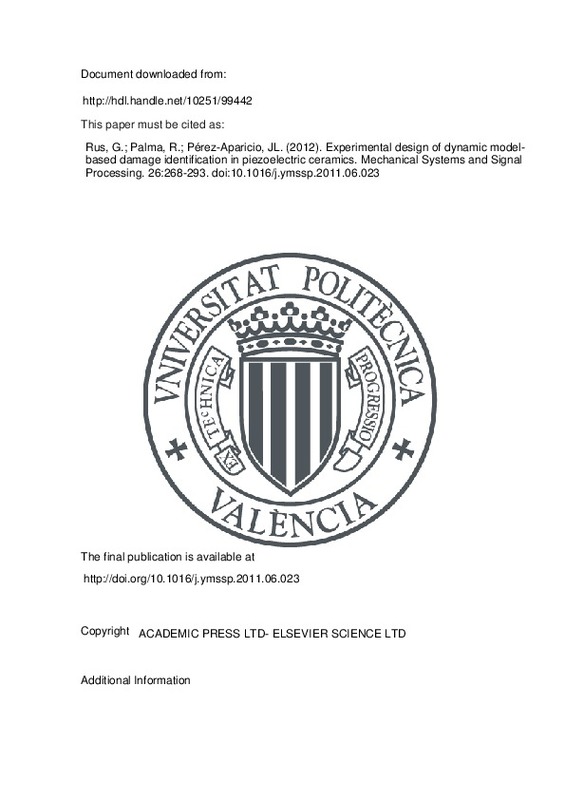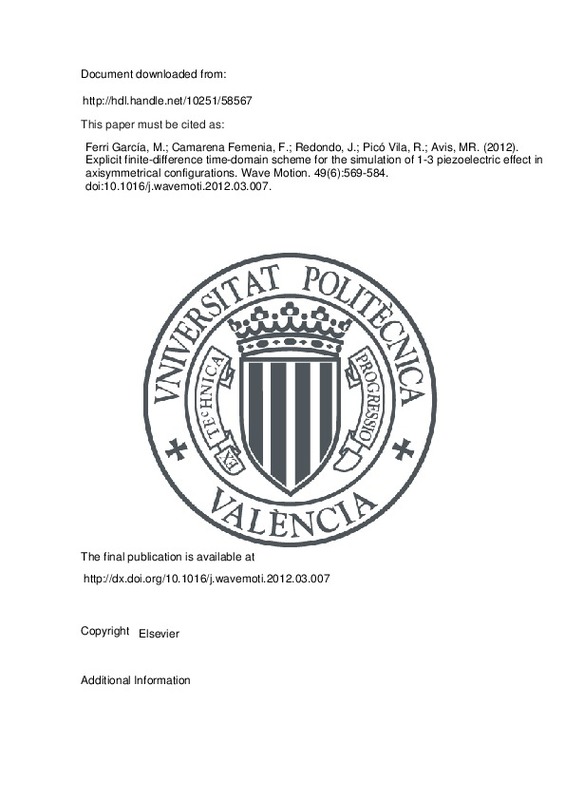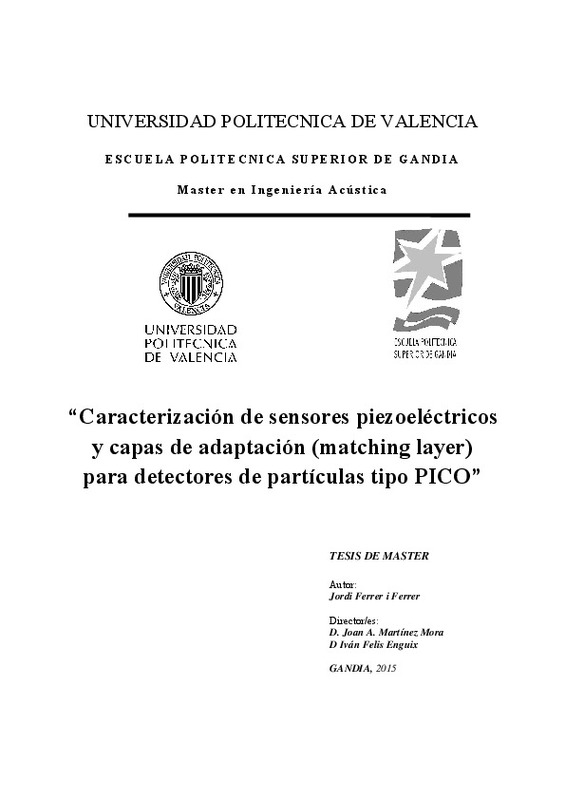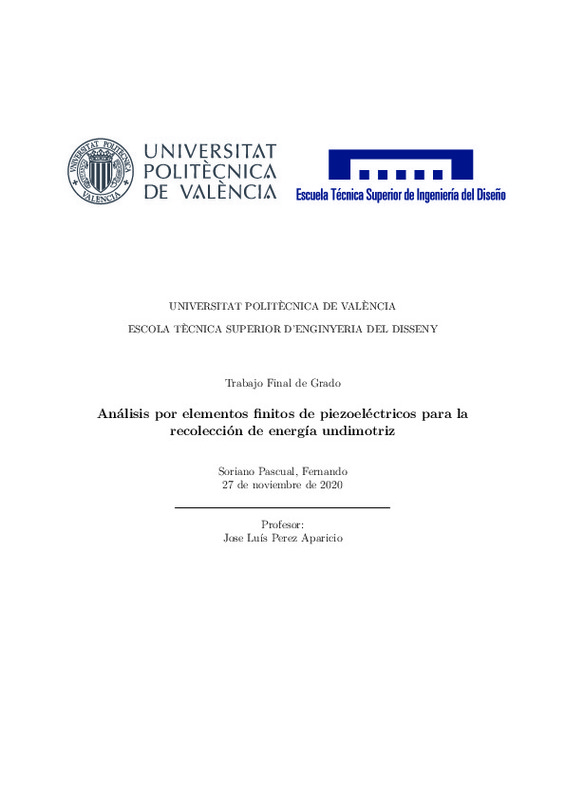Rus, G.; Palma, R.; Pérez-Aparicio, JL. (2012). Experimental design of dynamic model-based damage identification in piezoelectric ceramics. Mechanical Systems and Signal Processing. 26:268-293. https://doi.org/10.1016/j.ymssp.2011.06.023
Por favor, use este identificador para citar o enlazar este ítem: http://hdl.handle.net/10251/99442
|
Título:
|
Experimental design of dynamic model-based damage identification in piezoelectric ceramics
|
|
Autor:
|
Rus, Guillermo
Palma, Roberto

 Pérez-Aparicio, José L.
Pérez-Aparicio, José L.
|
|
Entidad UPV:
|
Universitat Politècnica de València. Departamento de Mecánica de los Medios Continuos y Teoría de Estructuras - Departament de Mecànica dels Medis Continus i Teoria d'Estructures
|
|
Fecha difusión:
|
|
|
Resumen:
|
[EN] A model-based inverse problem strategy is proposed for damage characterization, starting from the electromechanical response measurement as input data, and incorporating a numerical model that simulates the piezoelectric ...[+]
[EN] A model-based inverse problem strategy is proposed for damage characterization, starting from the electromechanical response measurement as input data, and incorporating a numerical model that simulates the piezoelectric response. Furthermore, a sensitivity analysis is developed to provide a rational basis to correctly design the excitation/measurement system. The model-based inverse problem is solved by minimizing a cost functional using genetic algorithms. The cost functional or discrepancy is defined as the L-2 norm of the difference between experimental and simulated measurements. The latter are obtained by solving the forward problem, using a novel 2D dynamic piezoelectric finite element. The effects of measurement noise and model uncertainties are studied in detail through a sensitivity analysis, where a sensitivity factor is defined and implemented. The proposed inverse problem strategy reconstructs the defect characteristics with sufficient precision, under realistic levels of noise. © 2011 Elsevier Ltd. All rights reserved.
[-]
|
|
Palabras clave:
|
Damage identification
,
Finite element method
,
Genetic algorithms
,
Inverse problem
,
Piezoelectrics
,
Cost functionals
,
Damage characterization
,
Electromechanical response
,
Finite Element
,
Forward problem
,
Input datas
,
Measurement Noise
,
Model uncertainties
,
Numerical models
,
Piezoelectric response
,
Sensitivity factors
,
Inverse problems
,
Piezoelectric ceramics
,
Piezoelectricity
,
Sensitivity analysis
,
Uncertainty analysis
,
Damage detection
|
|
Derechos de uso:
|
Reconocimiento - No comercial - Sin obra derivada (by-nc-nd)
|
|
Fuente:
|
Mechanical Systems and Signal Processing. (issn:
0888-3270
)
|
|
DOI:
|
10.1016/j.ymssp.2011.06.023
|
|
Editorial:
|
ACADEMIC PRESS LTD- ELSEVIER SCIENCE LTD
|
|
Versión del editor:
|
http://doi.org/10.1016/j.ymssp.2011.06.023
|
|
Código del Proyecto:
|
info:eu-repo/grantAgreement/MICYT//DPI2002-04472-C02-02/
info:eu-repo/grantAgreement/MEC//-2006-0237/ES/-2006-0237/
info:eu-repo/grantAgreement/Junta de Andalucía//P08-TEP-03641/ES/Detección de defectos en materiales compuestos avanzados de uso aeronáutico mediante técnicas vibro-acústicas y modelos de optimización/
|
|
Agradecimientos:
|
The authors would like to thank the Ministerio de Innovacion y Ciencia, Spain, for the FPU Grant AP-2006-02372 and also from Grants Excelencia Junta Andalucia P08-TEP-3641, MCyT DPI 2002-04472-C02-02. Authors would also ...[+]
The authors would like to thank the Ministerio de Innovacion y Ciencia, Spain, for the FPU Grant AP-2006-02372 and also from Grants Excelencia Junta Andalucia P08-TEP-3641, MCyT DPI 2002-04472-C02-02. Authors would also like to thank Prof. Rafael Gallego for his invaluable contributions to the development of the present work.
[-]
|
|
Tipo:
|
Artículo
|







![[Cerrado]](/themes/UPV/images/candado.png)





